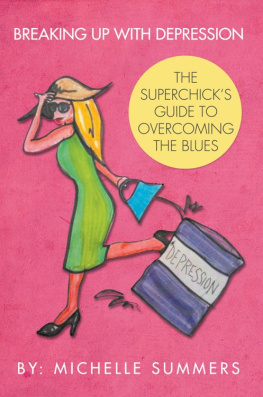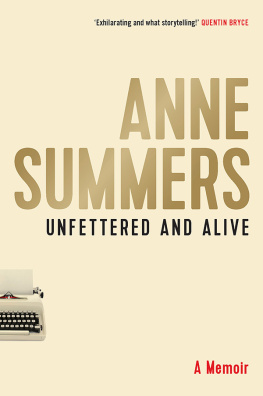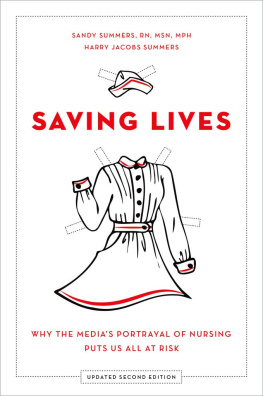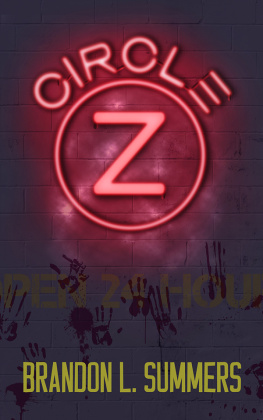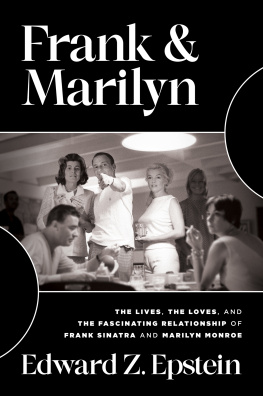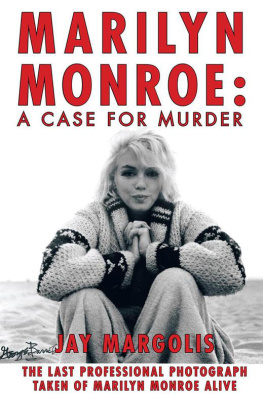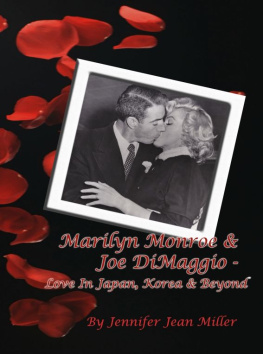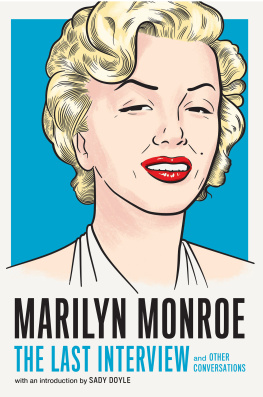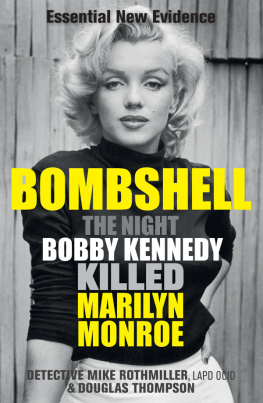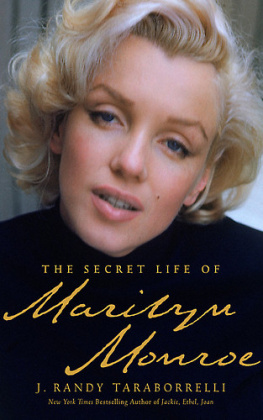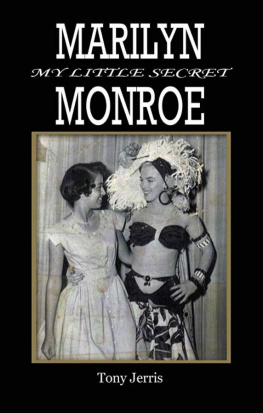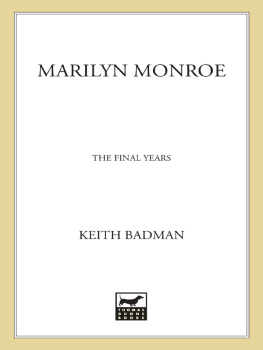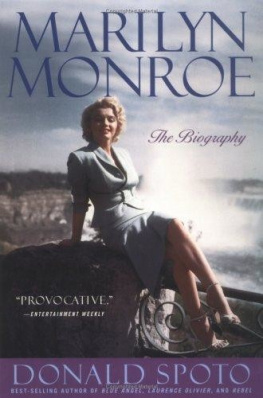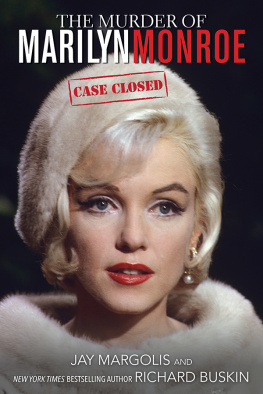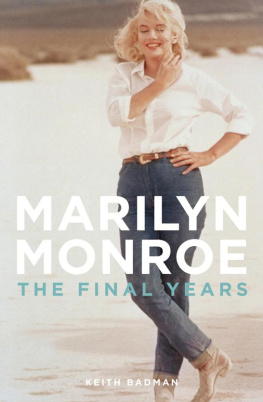
Goddess
The Secret Lives of Marilyn Monroe
Anthony Summers

for Olga and Ronan
Youre right about her not being easy to know. One sees her with intensity sees her more than one sees almost anyone; but then one discovers that that isnt knowing her.
HENRY JAMES
The Wings of the Dove
She did originate something. She was the first person I know of who was truly unconventional. She was a sixties person before it started way before it started like ten years.
ARTHUR MILLER
I cant tell the whole story Talk to Robert Kennedy.
DR RALPH GREENSON,
MONROES PSYCHIATRIST
Part One
INTO THE LAND OF THE SCORPIONS
The Industry giveth, and the Industry taketh away. Hollywood, the dream factory, had created a dream girl. Could she awaken to reality? And what was the reality? Was there a life for her outside the dream?
NORMAN ROSTEN,
Poet and Marilyns longtime friend
In Hollywood, starlet is the name for any woman under thirty not employed in a brothel.
BEN HECHT,
with whom Marilyn did her first major interviews
1
THE HOUR BEFORE MIDNIGHT, Saturday, August 4, 1962, in Los Angeles. In the auditorium of the Hollywood Bowl, under a sickle moon, the crowd was listening to the bittersweet strains of the Henry Mancini orchestra.
Abruptly, unnoticed by most of the concertgoers, there was a minor disturbance. An attendant, whispering apologetically, passed an urgent message to a man seated in one of the higher-priced seats. The man rose, walked to a telephone, and listened. Then he spoke a few terse sentences, summoned his wife, and hurried to his car.
In the night hours that followed, as Los Angeles slept, there would be other little incidents, more comings and goings. Telephones would jangle at bedsides around the city, rousing doctors, a prominent lawyer, leading figures in show business, and private detectives. A famous actor, brother-in-law of the President of the United States, would place a call to Washington. Some of the actors neighbors, in their fine houses on the beach, would be roused from sleep by the clatter of a helicopter. An ambulance would be summoned to an unpretentious house in the suburbs, on a mission the driver says he cannot recall.
The public would learn nothing of these nocturnal events, nor, so far as we know, were they recorded by any official body. Yet the event that triggered them was the news story of the year, one that received more coverage than even the Missile Crisis, the near-nuclear war that followed a few weeks later. Marilyn Monroe was dead.
Exactly twenty years later, in 1982, the Los Angeles District Attorney reopened inquiries into a case that had never ceased to be the subject of rumor and controversy. His brief was limited. Was there sufficient evidence to open a criminal investigation? Could Monroe have been murdered? After four months the DA was advised that the evidence fails to support any theory of criminal conduct. This, though, had been only a threshold investigation. It was indeed; the investigators did not even interview the detective who attended the scene of the death.
The 1982 report acknowledged that factual discrepancies and unanswered questions had surfaced during the Monroe inquiry. Privately, officials today make it clear that they felt they had stumbled into a morass of untruth and obfuscation. Marilyn Monroe may, they surmise, have died by her own hand. Yet they feel something was indeed covered up in 1962.
That something involved Monroes relations with President John Kennedy and his brother Robert and, in particular, Robert Kennedys activities at the time Monroe died.
The DAs men shrug ruefully when they discuss the Kennedy angle. We were not asked, says one, to investigate a political cover-up. With far less excuse, the press at the time preferred the easy wallow in pathos to serious reporting. Afterward, for all the profusion of writing about Marilyn Monroe, no qualified writer attempted a professional inquiry into the last days of the woman most firmly enthroned as the goddess of her century. Norman Mailer, who caused a stir with his book hinting at murder, came to regret not giving it my best effort.
Who was the woman who turned herself into Marilyn Monroe? She had a body, in truth, not so unlike other female bodies. How did she make us notice her more than any other woman, in her time and on into the end of the century? How much of this alchemy was achieved by talent, how much in the carefully chosen embraces of powerful males? What was at the hidden center of the phenomenon that was Marilyn Monroe?
Behind the hyperbole and the hysteria there was a child who grew to be a woman, who was a symbol of love yet essentially lonely, who died famously but in folly at the age of thirty-six. She postured as the worlds mistress, yet yearned for monogamy and motherhood. The profile was crude while the pursuit was for culture. The brilliance of the actress masked a seriously disturbed psyche. The private person read philosophy and planned gardens, yet drowned in drugs and alcohol. Marilyn Monroe anticipated a decade that trumpeted fulfillment and achieved only confusion.
She told her last interviewer: When youre famous you kind of run into human nature in a raw kind of way People you run into feel that, well, who is she who does she think she is, Marilyn Monroe? Its nice to be included in peoples fantasies but you also like to be accepted for your own sake.
With another reporter, a few months earlier, she had mused, I wonder how Ill feel when Im fifty? Then, her mind turning to birthdays, she mentioned that she was born under the sign of Gemini.
What kind of people are Geminis? the reporter asked.
Jekyll and Hyde. Two in one, came the reply.
And thats you?
More than two. Im so many people. They shock me sometimes. I wish I was just me! I used to think I was going crazy, until I discovered some people I admired were like that, too.
Marilyn and we may call her Marilyn because that is how she is known from Connecticut to the Congo never saw her fortieth birthday, let alone her half-century. Were she alive today hard to believe she would be in her late eighties. Yet her life long remained as unreliably reported as her death had been.
I thought it time to grant this goddess a measure of reality. Who do we think she was?
In 1983, unrecognized by passers-by, an elderly woman wearing a bucket hat regularly sallied forth into the streets of Gainesville, Florida, riding a tricycle with a red danger flag on the handle bars. The woman was a surprising survivor Marilyns octogenarian mother, living out her life in virtual anonymity.
Gladys Monroe for Monroe was the name of Marilyns maternal grandmother was born in 1902, in Mexico, of American parents. By the age of twenty-four she had been married twice and borne two children, who were raised by relatives of her first husband. The second husband did not last long. He was gone by the time Marilyn was born on June 1, 1926, in Los Angeles General Hospital.
We do not know for sure who Marilyns father was. Her birth certificate identifies him as Edward Mortenson, and her mother was married to a Martin E. Mortensen two years before Marilyns birth. It appears he was a Norwegian immigrant, a baker who died in a motorcycle accident in 1929, but even that is disputed. At all events, although she used his name on official documents throughout her life, Marilyn later denied that Mortenson was her father.
Next page

